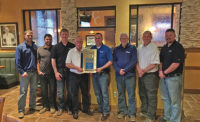PHCP-PVF distributors look to hire new talent
Early bird gets the worm.

One of The Collins Companies’ key initiatives on the hiring front was the addition of in-house mechanical engineers, who turned out to be Kyle Gerner (left) and Giovann Giarratana. The UConn grads are shown at a university STEM job fair last year. Photo courtesy of The Collins Companies.

Brooklyn, N.Y.-based Solco Plumbing Supply has seen success in attracting new talent through its presence at local job fairs. Photo courtesy of Solco Plumbing Supply.


It’s no secret that the PHCP-PVF industry is facing challenges when it comes to finding new talent to bring into companies.
“A frequent conversation with our associates and customers is the increasing difficulty to find talent,” says Kerri Mathews, director of recruitment and talent at Ft. Worth, Texas-based MORSCO. “It’s not uncommon to sit with a customer at one of our counters and hear about their struggles recruiting. Likewise, our associates in the field have periods of difficulty with recruitment. Just like many experts predicted, we are starting to feel a shortage for particular experience levels. Individuals with 10-15 years of professional experience are harder to recruit because they are preferable to many employers and have more employment options, especially when it comes to backfilling retiring leaders. Need proof? Just ask anyone around the age of 40 how often recruiters contact them on LinkedIn. I know our superstars are approached two or three times a week.”
American Supply Association Member Services Manager Bill Erfort is hearing a similar refrain from ASA members and prospects he talks to. “The job situation isn’t horrible, yet,” he says. “In the next few years the industry definitely will start to feel the impact of a workforce shortage. The members and prospects I’ve had a chance to talk to say they have very low turnover with a lot of long-tenured employees. A lot of our members are going to struggle with hiring new employees simply because it’s not something they regularly have to do. The problem isn’t going to be finding drivers and pickers, but finding middle management people and salespeople.”
Erfort predicts the shortage will be of concern to the entire supply chain. “Distributors already run lean staffs and they need to be ready for the upcoming shortage,” he says. “With such a premium put on college education and not wanting a career in physical labor, manufacturing, warehousing and distribution don’t seem desirable anymore for young, qualified job seekers. That’s where ASA and its members need to change that image.”
MORSCO is one of many PHCP-PVF distributors working hard to address this concern head-on through the execution of proactive recruiting methods that are helping replenish the talent pipeline and making sure new recruits continue on the career-development path.
Tools of the trade
At the start of 2016, MORSCO added a recruiting and talent-development department to the array of resources it offers its branch locations. “The department operates like a third-party recruiter with the added benefit of career coaching for better placement and career development of potential associates,” Mathews says.
East Windsor, Conn.-based The Collins Companies, an industrial PVF distributor, is using a host of recruiting methods, including referrals, local recruiting agencies, job fairs at the University of Connecticut, the sponsoring of two scholarship programs at local colleges and the use of a careers button on its website that has generated many leads on potential employees.
“It’s hard to attract people from outside the industry,” says Toni Wall, new business development manager at The Collins Companies. “Our industry isn’t the newest and greatest, it’s a legacy. You have to appreciate what you do every day helps build our industry—literally and figuratively.”
Brooklyn, N.Y.-based Solco Plumbing Supply has enjoyed recruiting success by attending local job fairs. “The largest hurdle we face is getting people to stop at our booth. It is difficult to contend with large companies such as Apple, Google and Merrill Lynch,” Solco Director of Purchasing Mike Hoopingarner says. “To combat this, I attend every job fair and I bring one of my recent hires with me. When college graduates see two fellow millennials at a booth, it shouts ‘Come talk to us! We have young people working at our company.’ I then share my success story of having started in the warehouse seven years ago and now I run the purchasing department, and I have my colleague share his experiences about the training program he currently is in and the future Solco can provide. There are a lot of benefits to working for a medium-size family-owned business that a large corporation can’t offer, so we try to stress those points.”
ASA is doing its part through a host of initiatives. An ASA Career Day Kit gives members everything they need to successfully participate in a career fair, including a how-to-guide on effectively hosting a career day. The association continues to reach out to high schools, colleges and military bases around the country, and also is helping members with career areas on their websites.
“We want to make it obvious where someone can inquire about open positions or what it’s like to be a part of a particular company,” says Erfort, who notes ASA’s Careers page at www.asa.net/careers is loaded with useful recruitment information.
Earlier this month, ASA launched a multi-tiered campaign to nearly 40,000 high-school, college and technical schools seeking opportunities to address students about the wide range of career opportunities that exist throughout the PHCP and PVF industry.
Beyond the recruiting process
While it is important to attract new talent into the industry, making sure they are properly trained and satisfied with their career path are points of equal importance, distributors say.
Solco has a “Ladder to Success Management Trainee Program” that allows new employees to learn the business from the bottom up, work in many different positions, find the job they love to do, and progress and excel within that department. “I personally prepare a training program unique to each individual and stay involved in every aspect of the training,” Hoopingarner notes.
Elkins W. Va.-based Valley Supply uses ASA training materials, as well as peer-to-peer training where a company veteran is paired with a new person until the new person is ready “for the training wheels to come off,” company CEO Rogers Earl Jr. says.
The Collins Companies also utilizes ASA training materials, including an on-boarding map, and uses manufacturers’ training seminars to provide employees an overall view of the industry.
Referrals also have been a jolt in the arm for companies. MORSCO gets referrals from individuals who have been through the recruiting process.“They report having a positive experience during the recruitment process and are happy to help us find talent and are confident referring their friends and colleagues,” Mathews says.
The Collins Companies benefitted from a self-referral when a past employee saw a job posting on a jobs website and expressed interest in coming back to work after a previous positive experience.
Mathews recommends companies hit the innovation button when it comes to recruitment. “Foster a perspective change on associate placement and retention,” she says. “Invest in people early in the hiring process as well as during employment no matter how long that lasts at your company. Invest in your current associates, not only because they deserve it but because it also creates referrals that endure recruiting challenges. Taking the time to care about the careers of all associates, present and future, makes recruiting easy.”
Earl Jr. says leave no stone unturned. “Do not stop looking for good customer-service employees,” he says. “You can train technical things about the job easier than you can train the customer-first attitudes. Always carry business cards with you because you may stumble across someone at a store or restaurant that stands out above everyone else there. These are the people who will make a difference in your business.”
Hoopingarner stresses recruitment is only the beginning. “Get people in the door, create a structured program and always have someone mentor them,” he says. “You have to find something your company can offer to prospective employees and sell it.”
ASA’s Erfort suggests even if a company isn’t hiring, to still be proactive on the recruitment front. “Promote your company, the industry and future careers,” he says. “In business, and especially our commodity-driven business, you always want to stay ahead of trends. This trend will be hitting us sooner than we realize and we need to be ready for it.”
This article was originally titled “Early bird gets the worm” in the September 2016 print edition of Supply House Times.
Looking for a reprint of this article?
From high-res PDFs to custom plaques, order your copy today!








